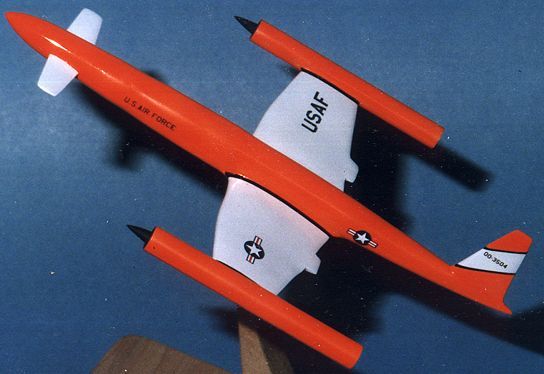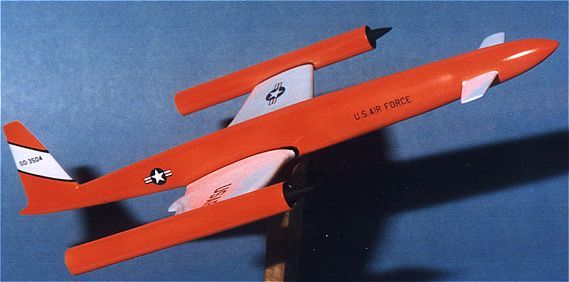
Kit: Hypersonic Drone a.k.a. Merlin 1/72 Meteor Mk8 
Date of review: December 26 1998
Review and Photos by: Scott Van Aken
Our club had a contest that required one to use a Merlin kit. One coulddo anything to the kit as long as 50% of the kit was used. My decisionwas to use the Meteor F.8 kit to build a futuristic aircraft. The ideacame from a book I have celebrating the 50th anniversary of flight back in1953. On the last page of the book was an artists rendition of a hypersonicinterceptor of the future (like 1970). It was clean looking and appearedto be a powered by two wingtip-mounted ramjets. So, I used it as a basisfor my kit.
Well if you have ever built a Merlin kit, you know that they are not theeasiest to build. The parts are very thick and fit is questionable. You definitely use your modeling skills with one of these!. Iused the fuselage, wings and part of the horizontal stabilizer from the kit. The rest came from the spares box, sheet styrene and Evergreen tubing.
 The fuselageof the kit is in four parts. Those were glued together and the firstof the filling began. Once that was semi-OK, I then looked around forsomething to use for the nose and to lengthen the fuselage. I founda SAAF Buccaneer slipper tank from the Airfix 1/48 kit to use for the noseand wrapped a sheet of styrene around it to mate to the fuselage of the Meteor.For the tail, I hacked off a portion of the Meteor horizontal stab and gluedit to the stub of the Merlin kit. Much, much, much, filler and sandinglater, the fuselage was relatively smooth. The wings were just thekit wings minus the engine pods.
The fuselageof the kit is in four parts. Those were glued together and the firstof the filling began. Once that was semi-OK, I then looked around forsomething to use for the nose and to lengthen the fuselage. I founda SAAF Buccaneer slipper tank from the Airfix 1/48 kit to use for the noseand wrapped a sheet of styrene around it to mate to the fuselage of the Meteor.For the tail, I hacked off a portion of the Meteor horizontal stab and gluedit to the stub of the Merlin kit. Much, much, much, filler and sandinglater, the fuselage was relatively smooth. The wings were just thekit wings minus the engine pods. 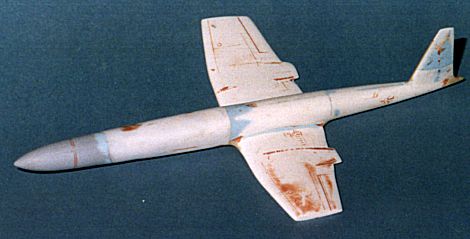 Allthe engraved detail and various lumps, bumps and imperfections were filledand/or sanded. I tried to get a nice airfoil section by trimmingdown the trailing edge.
Allthe engraved detail and various lumps, bumps and imperfections were filledand/or sanded. I tried to get a nice airfoil section by trimmingdown the trailing edge.
The real poser was the wingtip engines. I had originally thought touse brass tubing, but was having difficulty finding just the right size. Then there was the problem of attaching them to the wingtip. Thiswas all solved by the use of Evergreen tubing. Frankly, I will probablynever use brass tubing again for large items. It was perfect. Sinceramjets are pretty much a dead end for propulsion (at least now), this aircraftneeded proper turbojets. Like the SR-71 ! That meant intake cones.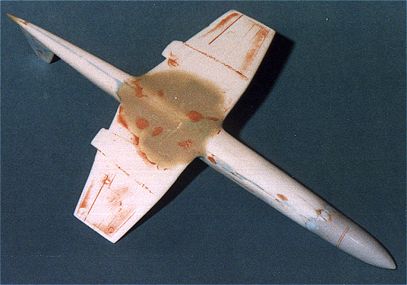 Thesewere developed by getting some Heller Mirage IIIE skinny fuel tanks, choppingoff the ends, and attaching them to circles that fit inside the tubing. The tubing was fit to the wingtips by slicing into them with a dremel,sliding them on the wingtip, aligning them and then fairing them in.
Thesewere developed by getting some Heller Mirage IIIE skinny fuel tanks, choppingoff the ends, and attaching them to circles that fit inside the tubing. The tubing was fit to the wingtips by slicing into them with a dremel,sliding them on the wingtip, aligning them and then fairing them in.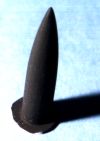
Something was still missing. Yes, the foreplanes. These werescavenged from the wings of a Huma Me-209 v3. They were filled andsanded, ready to install. I installed them by drilling a hole in theroot of each and inserting a bit of paperclip. Then holes were drilledin the nose area to accept them. The kit was ready for primer andpainting.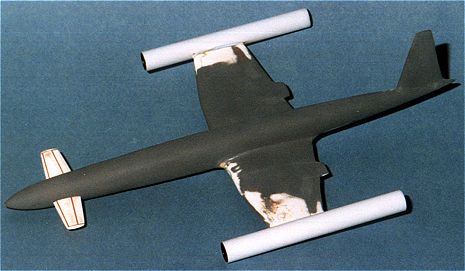
After primer (and more filling and sanding), the entire airframe was paintedgloss white as in the 1953 image. It looked very blah! It needed somecolor. Thinking back to a trip to Tyndall AFB and a tour of the dronefacilities, I decided that this would be a hypersonic drone. Dronesare always very colorful. What better color than Day-Glo! Humbrolgloss Blaze was the paint of choice. Unlike other day-glo paints, thiscovered very well and was not the pain it could have been. It is more ofan orange than a red and is really bright in the sunlight. The wingsthemselves and a section of tail were kept white. Decals were usedat the wing roots and tips to set off the different colors. Decalscame from the spares box and various Scalemaster sheets. It was then plunkedon a stand. Overall, a rather interesting diversion from the norm.While it did not win the contest, it looks great and is a big change fromthe usual Tamiya/Hasegawa/Italeri.......kits that I normally build.
